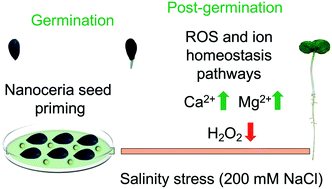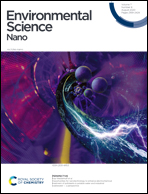Emerging investigator series: molecular mechanisms of plant salinity stress tolerance improvement by seed priming with cerium oxide nanoparticles†
Abstract
Engineered nanomaterials interfaced with plant seeds can improve stress tolerance during the vulnerable seedling stage. Herein, we investigated how priming seeds with antioxidant poly(acrylic acid)-coated cerium oxide nanoparticles (PNC) impacts cotton (Gossypium hirsutum L.) seedling morphological, physiological, biochemical, and transcriptomic traits under salinity stress. Seeds primed with 500 mg L−1 PNC in water (24 h) and germinated under salinity stress (200 mM NaCl) retained nanoparticles in the seed coat inner tegmen, cotyledon, and root apical meristem. Seed priming with PNC significantly (P < 0.05) increased seedling root length (56%), fresh weight (41%), and dry weight (38%), modified root anatomical structure, and increased root vitality (114%) under salt stress compared with controls (water). PNC seed priming led to a decrease in reactive oxygen species (ROS) accumulation in seedling roots (46%) and alleviated root morphological and physiological changes induced by salinity stress. Roots from exposed seeds exhibited similar Na content, significantly decreased K (6%), greater Ca (22%) and Mg content (60%) compared to controls. A total of 4779 root transcripts were differentially expressed by PNC seed priming alone relative to controls with no nanoparticles under non-saline conditions. Under salinity stress, differentially expressed genes (DEGs) in PNC seed priming treatments relative to non-nanoparticle controls were associated with ROS pathways (13) and ion homeostasis (10), indicating that ROS and conserved Ca2+ plant signaling pathways likely play pivotal roles in PNC-induced improvement of salinity tolerance. These results provide potential unifying molecular mechanisms of nanoparticle-seed priming enhancement of plant salinity tolerance.

- This article is part of the themed collections: Nano-bio interactions and Emerging Investigators Series


 Please wait while we load your content...
Please wait while we load your content...
